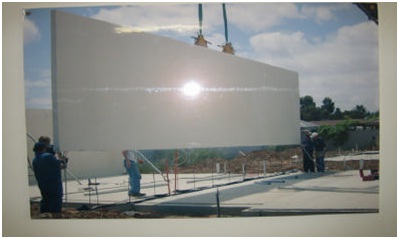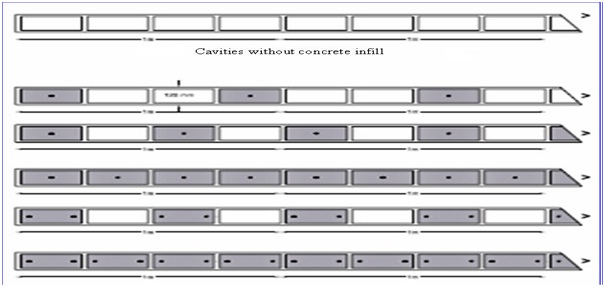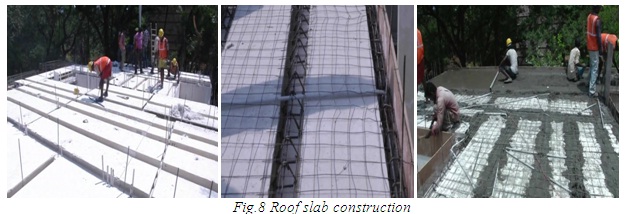





Published on Nov 30, 2023
There is a huge growing requirement of building materials in India due to the existing housing shortage of 24.7 million units ( 2007) mainly for the low income groups in urban India. Estimated urban housing shortage in 2012 is 26.53 million, while the housing shortage of rural India in 2012 is 42 million units. Thus total estimated housing shortage for Urban & rural India in 2012 is 68.53 million units.
To meet this challenge, India requires innovative, energy efficient building materials for strong and durable housing in fast track method of construction at affordable cost. It is also important that housing and buildings are disaster resistant to protect the lives and properties of people. All these concerns are involved in sustainable and inclusive development.
Rapidwall Panel provides rapid or faster construction and contributes to environmental protection, providing a solution to many of the above issues and concerns. The paper describes the method of construction using Rapidwall panels based on construction manual prepared by IIT Madras to suit Indian situation. FACT & RCF, two fertiliser giants under public sector are together setting up Rapidwall and plaster products manufacturing plant at Ambalamugal using Rapidwall technologies of Australia called FACT RCF Building products Ltd. (FRBL). FACT has about 7 million tons of industrial by product gypsum. By setting up Rapidwall & Plaster products plant, they intend to produce 1.4 million sqm or 15 million sq ft panel per year and about 50000 tons of superior quality wall plaster and wall putty.
The threat of climate change caused by the increasing concentration of greenhouse gases in the atmosphere is pushing the whole world into a catastrophic crisis situation with universal concern. The need of the 21st century is for energy efficient and eco-friendly products. The building industry accounts for 40% of CO2 emissions. Building construction causes CO2 emissions as a result of embodied energy consumed in the production of energy intensive building materials and also the recurring energy consumption for cooling and heating of indoor environment. Rapidwall, also called gypcrete panel is an energy efficient green building material with huge potential for use as load bearing and non load bearing wall panels.
Rapidwall is a large load bearing panel with modular cavities suitable for both external and internal walls. It can also be used as intermediary floor slab/roof slab in combination with RCC as a composite material. Since the advent of innovative Rapidwall panel in 1990 in Australia, it has been used for buildings ranging from single storey to medium - high rise buildings. Light weighted Rapidwall has high compressive strength, shearing strength, flexural strength and ductility. It has very high level of resistance to fire, heat, water, termites, rot and corrosion. Concrete infill with vertical reinforcement rods enhances its vertical and lateral load capabilities. Rapidwall buildings are resistant to earthquakes, cyclones and fire.

Phosphogypsum which is a byproduct of phosphoric acid plant is calcined in calciner at 140-1500 C at the rate of 15MT/hr of calcined plaster. This calcined plaster is stored in product silo having capacity of 250MT. The plaster is then transferred to batch hopper by screw conveyors and through Entoleter in wall panel manufacturing area. This area consists of 6 casting tables having dimensions of 3m x12m, one crab having mixer and glass roving delivery system is for delivering slurry and glass roving for three tables. The chemicals are added in water & mixed and then plaster is added & mixed to form slurry. One layer of slurry is laid on the table by the crab followed by a layer of glass roving. This glass roving is embedded in to the slurry with the help of screen roller. Another layer of slurry is poured followed by a layer of glass roving this layer is pushed inside the ribs with the help of temping bar.
Finally a layer of glass roving is laid for the top face of the wall panel. After getting final Gilmore wall panel is lifted from the casting table to ACROBA frame and shifted to dryer for drying. The wall panel is dried at a temperature of 275˚C for 60 minutes. After drying, the wall panel is either shifted to storage area or on the cutting table. The wall panel is cut as per dimensions supplied by the consumer and the cut pieces are transferred to stillages which are specially made for transporting wall panel. The liquid effluent generated during manufacturing process is recycled back in the system for manufacturing of new wall panels. The solid waste which is generated while manufacturing wall panels is recycled back to the calciner after crushing and separating plaster & glass roving in recycle plant. The above system is a batch process. Six wall panels can be manufactured in eight hour shift per table. Similarly, 36 wall panels can be manufactured in eight hour shift with 6 tables. Flow diagram of the system showing the manufacturing process is attached herewith.
It shall be done at appropriate stages of manufacturing process. The inspected panels shall be stored & packed to ensure that no damage occurs during transportation. As part of quality assurance regular in process inspections shall be carried out by the trained personnel of the PAC holder.
Wall to wall ‘L’, ‘T’, ‘+’ angle joints and horizontal wall joints are made by cutting of inner or outer flanges or web appropriately and infill of concrete with vertical reinforcement with stirrups for anchorage. Various construction joints are illustrated in Fig.3.

Rapidwall Panel can also be used for intermediary floor slab / roof slab in combination with embedded RCC micro-beams and RCC screed concrete
Panels are vertically loaded at the factory on stillages for transport to the construction sites on trucks. Each stillage holds 5 or 8 pre-cut panels. The stillages are placed at the construction site close to the foundation for erection using vehicle mounted crane or other type of crane with required boom length for construction of low, medium and high rise buildings. Special lifting jaws suitable to lift the pane l are used by inserting into the cavities and pierced into webs, so that lifting/handling of panels will be safe.
For Rapidwall Housing a conventional foundation like spread footing, RCC column footing, raft or pile foundation is used as per the soil condition and load factors. All around the building RCC plinth beam is provided. Conventional water proofing materials are used in the foundation.
Rapidwall enables fast track method of construction. Conventional building construction involves various time consuming processes, like i) masonry wall construction ii) cement plastering requiring curing, iii) casting of RCC slabs requiring centering and scaffolding and curing iv) removal of centering and scaffolding and v) plastering of ceilings and so on. Construction time is minimized to 15-20% by the rapid wall method. Instead of brick by brick construction, Rapidwall enables wall by wall construction. Rapidwall also does not require cement plastering as both surfaces are smooth and even and ready for application of special primer and finishing coat of paint.
Door/window, openings will be cut and reinforced concrete is provided there.
Embedded RCC lintels are to be provided wherever required by cutting open external flange. Reinforcement for lintels and RCC sunshades can be provided with required shuttering and support.
After inserting vertical reinforcement rods as per the structural design and clamps for wall corners are in place to keep the wall panels in perfect position, concrete of 12mm size aggregate will be poured from top into the cavities. There is no need to use vibrator because gravitational pressure acts to self compact the concrete inside the water tight cavities. Generally every third cavity should be concreted.
An embedded RCC tie beam to floor/roof slab is to be provided at each floor/roof slab level, as an essential requirement of national building code against earth quakes. For this, web portion to required beam depth at top is to be cut and removed for placing horizontal reinforcement with stirrups and concreted.
Instead of a solid concrete floor slab, which is typically 100 to 150mm thick, the GFRG panels are used. They are placed horizontally over the walls in different roofs. The roofs typically spanning along the shorter direction. Concrete tie beams connect the panels to the walls at all junctions. Every third cavity in the horizontal GFRG panel is cut open from the top and reinforced cage is inserted to serve as a concealed beam. Further a steel welded mesh is placed on top of the entire floor slab and subsequently embedded in screed of concrete 50mm thick. The advantage with the system over conventional concrete slabs is the there is no need of shuttering and the finish at bottom is excellent. It also not required any plastering. Conduits for electrical work are kept in place before concreting the slab.

Vertical reinforcement of floor below shall be provided with extra length so as to protrude to 0.45m to serve as start up rods and lap length for upper floor. Once the wall panels are erected on the upper floor, vertical reinforcement rods, door/window frames fixed and RCC lintels shall be casted. Then concrete where required and joints shall be filled. Thereafter, RCC tie beams all around shall be concreted.
The PAC holder shall provide to the client details of water proofing treatment required at different levels of construction such as foundation, sunshade and flooring etc.
The stair case work is taken up using GFRG panels as the landing slab with reinforced concrete bars in all the cavities.
Once concreting of ground floor roof slab is completed, on the 4th day, wooden planks with support props in ground floor can be removed. Finishing of internal wall corners and ceiling corners etc can be done using wall putty or special plaster by experienced plasterers. Simultaneously, electrical work, water supply and sanitary work, floor tiling, mosaic or marble works, staircase work etc can also be carried out. Every upper floor can be finished in the same way.
Access to adequate shelter at affordable cost by low income section and common people is very important for India for inclusive development.. The booming of real estate and construction industry has indeed shot up the cost of construction due to the ever increasing cost of cement, steel, bricks, river sand, concrete materials and labour cost. In this situation, safe and good quality housing will become unaffordable to all the sections. Commonly used walling in India is brick masonry. Cost of brick wall with two sides cement plastering has increased by almost 4 times during the last 5 years. Brick wall construction cost was Rs 460/sqm in 2003. This increased to Rs 1700 /sqm in 2007. In view of likely increase in cost of energy, bricks, cement, river sand, water, labour and hire charges for scaffolding etc, the cost of masonry made of bricks or concrete blocks will continue to rise in future.
This will make Rapidwall panel much cheaper and affordable to the building industry while it will also help to protect the environment, as one sqm panel will save carbon emission reduction of about 80Kg. Rapidwall panel has excellent acoustic properties. Testing of panel by IIT Madras found that the panel belongs to a class of STC 40 with respect to air-borne sound insulation. Infill of cavities with locally available cheaper materials like quarry dust mixed with cement (1:20) and water or sand and cement (1:20) up to lintel/ window height can make the wall solid and address security-related concerns. Other than Australia and China, India is set to benefit from the technology as Rapidwall panels are to be manufactured and marketed in Mumbai within few months by RCF, one of the largest fertilizer company of Govt. of India.
FACT, another large public undertaking fertilizer company in joint venture with RCF is also setting up another rapidwall plant in Cochin. A Rapidwall plant near Chennai is also commissioning and marketing the product shortly. In Rapidwall construction, especially in repetitive type mass housing, time for construction will be reduced by 75-80% thereby reducing overall overhead establishment costs with reduced lock up investment period and less labour component. Comparative study of Rapidwall building and conventional building (2 storey 1500 sft) shows significant savings in Rapidwall buildings. Embodied energy of Rapidwall building is only 82921 kWh, while conventional same size building would have 215400 kWh, thereby saving 61.5% embodied energy.
Rapidwall Panel provides a new method of building construction in fast track, fully utilising the benefits of prefabricated, light weight large panels with modular cavities and time tested, conventional cast-in-situ constructional use of concrete and steel reinforcement. By this process, man power, cost and time of construction is reduced. The use of scarce natural resources like river sand, water and agricultural land is significantly reduced. Rapidwall panels have reduced embodied energy and require less energy for thermo-regulation of interiors.
Rapidwall buildings thereby reduce burdening of the environment and help to reduce global warming. Rapidwall use also protect the lives and properties of people as these buildings will be resistant to natural disasters like earthquakes, cyclone, fire etc. This will also contribute to achieve the goal of much needed social inclusive development due to its various benefits and advantages with affordability for low income segments also. Fast delivery of mass dwelling/ housing is very critical for reducing huge urban housing shortage in India. Rapidwall panels will help to achieve the above multiple goals.
• http://www.bmtpc.org/DataFiles/CMS/file/PDF_Files/24_GFRG_Panel_FRBL.pdf
• http://www.google.com/patents/US6878321?hl=en&output=html_text
• http://mhupa.gov.in/W_new/11_Meher%20Prasad_Tech%20for%20Mass%20housing.pdf
• http://www.youtube.com/watch?v=UUQEUcB7cMM
| Are you interested in this topic.Then mail to us immediately to get the full report.
email :- contactv2@gmail.com |